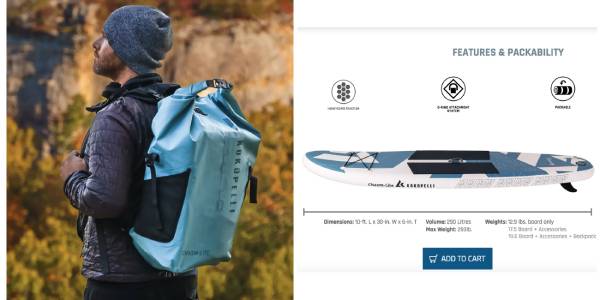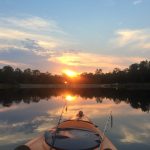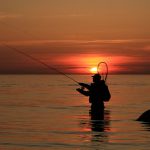If you are keen on kayak fishing models, let’s talk about the numerous possibilities. Researching tips and strategies is an excellent way to begin when getting into a new activity or undertaking.
When launching for the initial occasion, kayakers will have diverse techniques to do it, and there are many ways to go about it. You are unlikely to encounter two kayakers who possess the same equipment!
Canoeing with a kayak is a fabulous way to have fun since it offers a fantastic experience. Fishing off a pier provides an opportunity to experience fishing without being confined to the limits of land angling, while avoiding the high costs and fees associated with large boat ownership.
The portability of kayaks makes them an excellent choice for fishing. You don’t have to wait at a crowded boat ramp or worry about when to set sail since kayaking can be done from most places you can reach on foot.
Explore this ultimate guide to fishing from a kayak to learn everything there is to know about equipping a kayak for fishing.
Why is kayak fishing good?
Kayak anglers often claim that kayak fishing is a simple and cost-effective option for accessing the water and seeking out fish. It is simple to take a kayak out in both brackish and saltwater and generally there are no limitations on where you can go (though it’s best to stay away from main shipping routes!).
Many may consider it the perfect outdoor recreation activity.
If you’re currently fishing from shore, investing in a kayak for angling could be a wonderful way to experience the open water.
Almost anybody can paddle a kayak; it doesn’t take an extreme level of physical power to work. In fact, kayaking is a great way to exercise and improve your fitness, as it relies on the use of a paddle for propulsion.
Can you fish from a regular kayak?
Selecting a kayak designed especially for fishing is ideal, especially for newbies, though any kayak will suffice for fishing.
If you peruse numerous angling writings, you may be overwhelmed with guidance, and not all of it is appropriate for those looking for advice for kayak fishing for newcomers. Here are a few features you may want to think about:
- Elevated seating
- Multiple flush mount rod holders
- Paddle holder & safety strap
- Suitable storage – enclosed hatch and bungee straps
- Fish Finder mounts
- Overall weight
- Side-tracks to install swivel rod holders
- Storage area for lures and baits
Think about the environment in which you plan to use your fishing kayak and your own capabilities before making a purchase. If you are a beginner, try to find a furniture piece that is sturdy and has a lot of storage capability.
As your ability improves, you may want to switch to a machine that offers speed rather than stability later on. Determine how many fishing rods you plan to take with you and select a kayak that is equipped with adequate mounting points and enough rod holders.
If operating a paddle is not something that appeals to you, then you may want to look into kayaks that use pedals for their power source. A bicycle or other vehicle powered by pedaling is ideal because it provides good speed and keeps your arms unoccupied for other tasks!
Can you fish while kayaking?
Fishing from a kayak can be done in both a static and a dynamic way, meaning it is feasible to go angling while moving. Investing in a trolling motor and associated components for your kayak can provide you the advantage of being able to keep your hands unoccupied for fishing.
Although it’s two-person kayak, one person can paddle while the other just enjoys the scenery or fishes with a rod at the rear.
What is the best bait for kayak fishing?
The kind of bait you use will be based on the type of fish you are trying to catch. Given the restrictions of space, the most sensible option is to opt for baits or lures that require minimal preparation. If you intend to use bait that has to be broken into pieces, it is recommended that you cut it up before you begin your boating trip.
A lot of fishermen will refrain from using bait and will use lures to capture fish instead. Some fishers may have multiple rods ready, with some of them being stocked with lures and placed in sinkable rod holders, while they work with another pole with a bait.
Naturally, being attached to multiple lines brings its complications, however, having the chance to catch multiple fish simultaneously is something every angler would be delighted to have!
Is it hard to fish from a kayak?
Fishing from a kayak provides a distinct experience compared to other fishing techniques. Adapting to using the rod, line and reel when fishing is an acquired skill that requires practice.
Kayaking can be difficult for certain individuals due to the confined size, however, it can be exceptionally stimulating as it necessitates more thorough preparation before embarking on the journey.
The potential advantages of kayak fishing significantly outweigh any potential disadvantages when compared to other types of fishing. You can access areas not accessible to most people, and there is a strong bond between people who fish from kayaks.
An individual familiar with kayak fishing knows the obstacles that come with it and is typically willing to share advice so as to help those who are preparing to do it for the very first time.
What experience is needed for kayak fishing?
If you have experience fishing from land or from a boat, it would be wise to hone your kayaking skills before going on your next water excursion.
Locate a patch of smooth water when the air is calm and practice maneuvering and controlling your boat by paddling around in it. Once you have the foundation down of how to paddle, how to make turns and how to enter the kayak from the water, you are set to start your paddling journey.
Kayak Fishing Tips To Help You Catch More
1. Find The Right Fishing Kayak
Selecting the perfect kayak for your angling adventure can make all the difference between a successful journey and a failed one.
When selecting a yak, a key factor to remember is how steady it is. A sturdy vessel can offer you a more secure foothold while fishing, making it easier to cast out your line or haul in your prey.
Yaks tailored for fishing will generally be steady, and certain varieties possess the advanced steadiness needed to permit one to stand while fishing. Most fishing boats generally have extras as well, such as built-in rod holders and compartments for storing fishing equipment.
It’s possible that boats designed exclusively for angling may possess a broader seating section plus a higher quality seat. This will enable you to be out on the water for a longer duration, providing you with enough space to adjust your position or move around while angling.
2. Check Out The Local Fishing Forecast
Prior to leaving, it is beneficial to investigate the most optimum moments for fishing at the spot in question. Your nearest fishing shop is likely to get you this important data as well as other useful tips regarding tides, water height and flow.
It could be feasible to look up online via multiple local fishing message boards, or even on a mobile application. This may assist in discovering the optimum periods for fishing, and the times when it may be best to abstain.
3. Invest In A Fish Finder
Using a fish finder eliminates the guesswork when fishing. It is not always easy to figure out where the fish are, but with a fish finder, you can be made aware of their exact spots through the use of SONAR.
Using a fish finder can be immensely beneficial; it enables an angler to capture significantly more fish than they would without one. With the help of a depth finder, you can get an insight into the depth of the water you’re in and be aware of the topography of the area and any potential obstacles (or fish hideouts).
The Garmin Striker 4 type of fish finder can generally be attached to a kayak very simply and does not take up much space. This model includes a GPS, which means you can set points of reference on the path you are taking to simplify navigation.
4. Invest In A GPS Unit
A Global Positioning System device can be very helpful for people who are engaging in kayak fishing, especially if you would not like to use a fish finder. In addition to keeping you from becoming disoriented while on the water, this technology is useful for noting important locations and regions with abundant fish populations.
If you get lost, the GPS will retain your current route as well as any earlier ones you had, so you can find your way back to the starting point. You should also be able to figure out how to get back to the great location where you had such good luck catching fish the last time you were there.
A GPS system can also allow one to transfer a variety of maps to the gadget, so one can store them for utilizing on their canoeing journeys. Keep an eye on certain features if you are shopping for a GPS to use while kayaking; most importantly, make sure it is water resistant.
5. Pack Plenty Of Food And Water
When you plan to spend a considerable amount of time in the water, be sure to bring enough nourishment and hydration for the excursion. Having a few extra items on hand in case of an unexpected event can be beneficial.
Non-perishable foods like energy bars, dried fruits, and nuts are a great choice when wanting food that won’t spoil.
6. Make Sure You Have Sun Protection
When you’re out in a boat, you’re more vulnerable to the hazardous effects of the sun since UV rays can bounce off the sea. Sunscreen is a must if you want to avoid experiencing the agony of sunburn and stay outside fishing for a longer time.
Sunglasses and a hat are two necessities for extended exposure to the sun’s rays, as they reduces the impact of the sun on your skin.
Polarized sunglasses can help diminish the glare from the water’s surface, giving you a better chance of watching fish and performing tasks like reeling in a catch or attaching bait to the hook.
7. Check The Weather Forecast
Considering the weather in advance can be advantageous, particularly when making decisions. If you look up what the weather will be like before you depart, you can plan ahead and bring the right items with you on your journey.
If you plan to go fishing in a place where conditions can vary unexpectedly, you may want to bring various kinds of apparel and equipment to be prepared for any weather.
Looking at the forecast before embarking on a boating activity can keep you from encountering dangerous weather conditions. You should do everything possible to avoid getting engulfed in a storm or overturning your boat in choppy water.
8. Prepare To Get Wet
No matter what type of kayak you’re using, it is wise to be prepared for the possibility of capsizing, or getting sprayed with water on deck. It can be beneficial to wear garments that are water-resistant or fabrics that will dry quickly.
It’s recommended to wear attire that you could use to swim if an emergency situation arises for safety reasons. Consider what type of attire might get snagged on logs or branches if you were to tumble in the water and perhaps leave it behind before you begin your voyage.
You should consider bringing a bag of extra clothing along on a day trip, in case you need to switch out of your soaked attire.
Don’t forget a life jacket!
9. Secure Your Gear
Ensure that all your equipment such as your fishing rod, cooler, and extra clothes are safely placed on your vessel. Secure any objects that are not firmly attached by using bungee cords, and use a tether to ensure your belongings don’t drift away if they detach from your vessel.
Paddle leashes can be beneficial for fastening to your poles and other possessions.
10. Use An Anchor
If you are sitting in your kayak in anticipation of a bite, having a mooring point can be quite handy, particularly when you’re in a waterway with a current or an area with strong currents. The anchor can assist you in staying put in the water while freeing up your hands to use your fishing rod.
Conclusion: Getting started with kayak fishing
Once you purchase a kayak and have gone out a couple of times, you will gain knowledge and figure out the most efficient approach to ensuring your trip is a total triumph.
Kayaking is a budget-friendly and delightful way to spend time on the water and investigate the area you live in. Kayaks can easily be carried on top of your vehicle, and no matter the number of kayaks you have, they can be stacked together.




